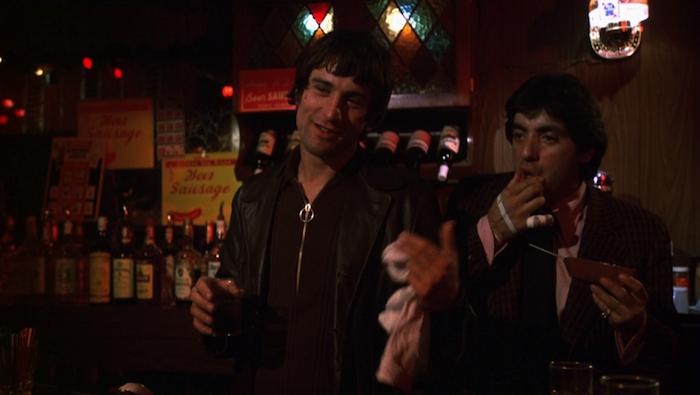The Needle Drop examines the relationship between a film and its soundtrack, how a song or score cue can set or upend the tone of a shot, a character, the movie itself.
In a film as full of moments between the interaction between music and image as Mean Streets, any number of scenes could be singled out as examples of this dynamic. Some, even for the same reason. But this one stands out the most, for simultaneously embodying one of the movie’s central dramatic conflicts in less than a minute of screen time with almost no dialogue, and foretells Martin Scorsese’s ability, seen many times over since, to use music as an ironic counterpoint to the action in a given scene.
The scene comes near the end of the film, immediately following Johnny Boy (Robert De Niro)’s impulsive decision to mortally insult the man to whom he owes a large sum of money, repeatedly calling him a “jerk-off” and “motherfucker” and waving a gun in his face; this confrontation is the culmination of an entire movie’s worth of evasions and delays on Johnny Boy’s part. Charlie (Harvey Keitel), being more circumspect than his friend, realizes the immediate need to get Johnny Boy the hell out of his antagonist’s way, as gentlemen who lend money tend not to take being called “jerk-off” and “motherfucker” by debtors lightly, particularly in the Little Italy milieu Scorsese depicts.
So it begins with Charlie getting into a borrowed car. He turns on the ignition. The radio begins playing “Mickey’s Monkey,” by Smokey Robinson & The Miracles. Rather than acting with any kind of urgency, Johnny Boy begins to dance around the garage. Charlie exhorts him to get in the car, but Johnny Boy continues to dance until he’s done dancing.
Acton-wise, that’s the entire scene. And yet within it is the entire dynamic between these two characters. Charlie wears tailored suits with monogrammed shirts. He has ambitions to follow his uncle into a career (in organized crime, but still). He operates in the world with caution and diplomacy, in the naïve belief that doing things the right way leads inevitably to things happening the way they should. Johnny Boy, conversely, is an anarchic spirit, with not a thought for anything in the past or future or any other point than the now, the immediate. He exists, in many ways, at others’ expense. Charlie, in particular, indulges him because the received morality that governs his life prizes loyalty. And, due to the problematic nature of Johnny Boy’s very existence, that loyalty to him as a friend causes Charlie no small degree of internal conflict.
In this scene, no matter how true to Charlie’s character it may be to sit behind the wheel helpless to do anything to get Johnny Boy to behave himself, the focus is squarely on Johnny Boy, dancing to “Mickey’s Monkey.” The song itself is one of the most purely exuberant songs ever written, the lyrics to its refrain not even English but voices chanting “lum de lum de la iiiii” ad aeterno. The beat doesn’t simply suggest dancing, it insists upon it. Smokey sings about “a cat named Mickey doing that monkey,” which is a reasonably apt description of the dance to which it compels Johnny Boy, an improvised affair, with less grace than pure sensual indulgence. Johnny Boy tops the dance off with sharp, repeated hand gestures somewhere between a slash and a punch.
Against the context of the scene, “Mickey’s Monkey” particularly stands out, as the deliriously terpsichorean song comes on abruptly at a moment when both men (or Charlie, at least) are in fear of imminent violent death. It’s telling of where Scorsese was to go as a filmmaker that right after these two guys realize if they don’t get out of the neighborhood they’re going to be killed—Charlie might escape death by handing over Johnny Boy, but if he was morally capable of doing so there’d be no conflict—that we pause to have a dance scene.
Charlie may be the surrogate for those in the audience wondering why the hell they aren’t getting their act together and getting as far away as possible immediately. But Johnny Boy is the reminder that things aren’t always quite that easy. He’s the one who, in spite of being the one whose life is more at risk, stops to be like, “Hey, this is a great song.” And is the one who, in the face of his own death, dances Mickey’s Monkey. In this brief, seemingly tossed-off scene, is the genius of Martin Scorsese.





















One thought on “The Needle Drop: ‘Mean Streets’ and “Mickey’s Monkey””
I just watched “Mean Streets” a few nights ago on Blu-Ray and remember this scene fondly. What amazes me about the scene is how realistic it is to its characters. Showing us the conflicted attitudes these two friends have on life. Also, I can’t possibly imagine a movie today doing this. A modern gangster/thriller wouldn’t stop to from its plot to show a character dance, but that shows Scorsese’s brilliance.